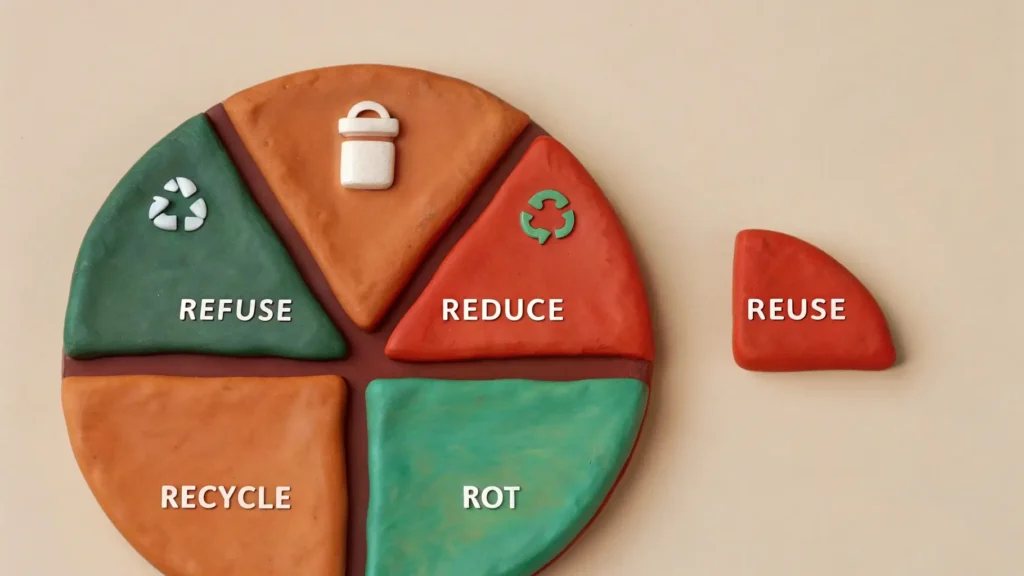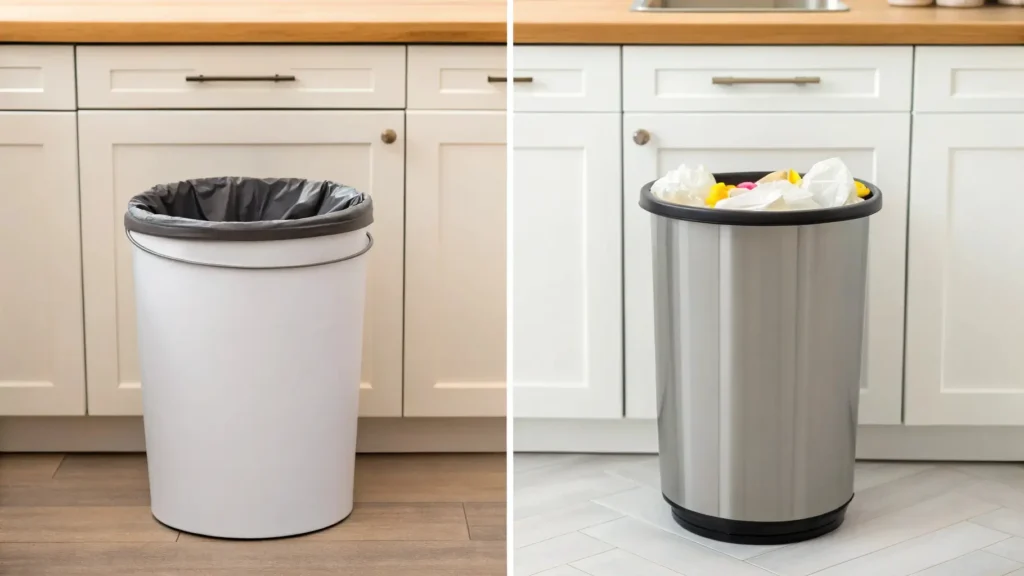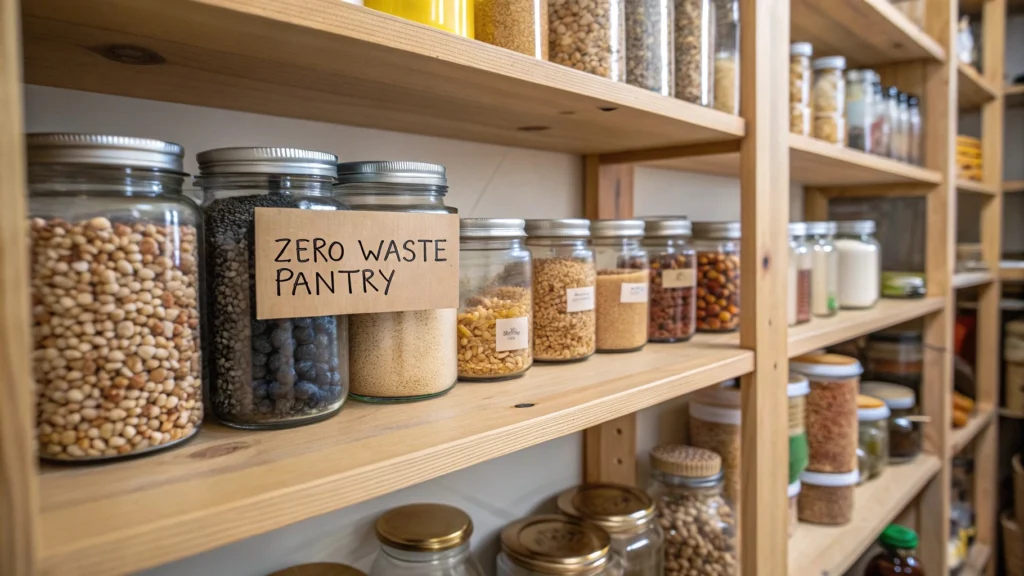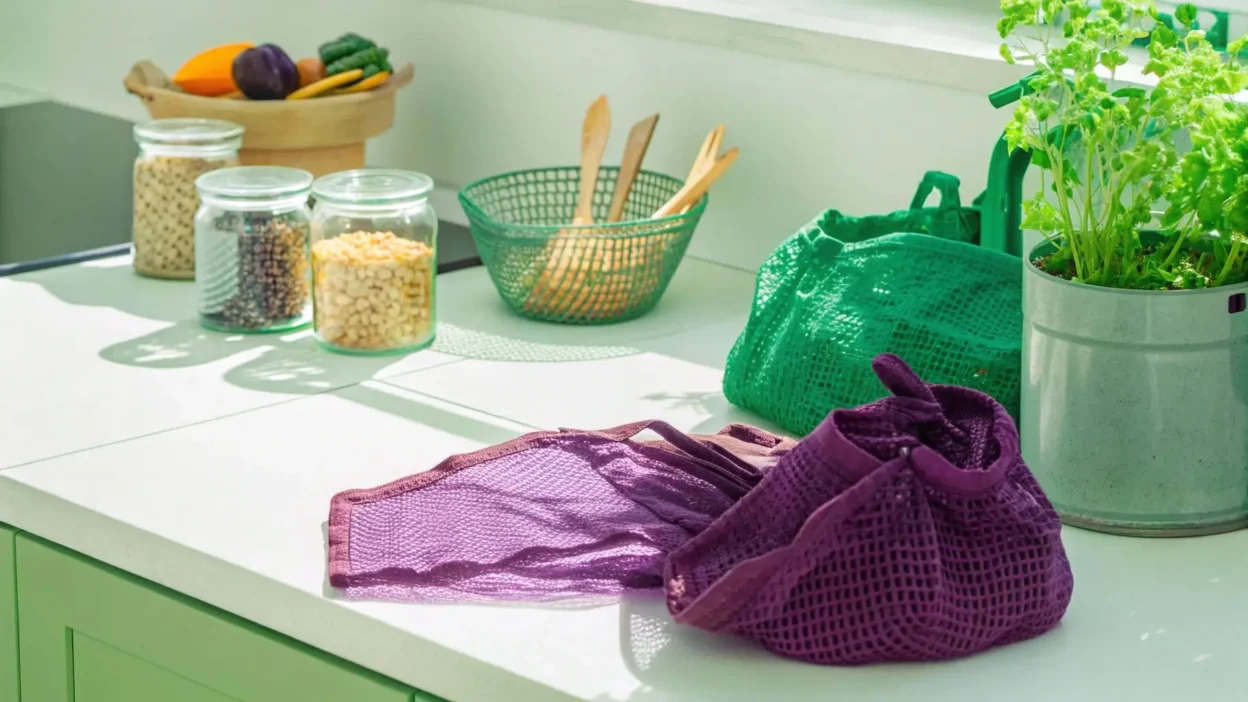Table of Contents
The Art of Living with Less Waste (But More Purpose)
Imagine you open your trash can after a full week, and it’s barely half full. Your kitchen counters gleam with mason jars filled with bulk goods, and your cleaning cabinet houses three simple ingredients that tackle every mess. Sound impossible? Welcome to the elegant world of zero waste living – where less truly becomes more.
This transformation isn’t just about reducing trash; zero waste living represents a fundamental shift in how we interact with our environment and possessions.
I remember the exact moment my perspective shifted. Standing in my kitchen, surrounded by empty takeout containers and plastic bags, I realized I was drowning in my own consumption. That uncomfortable truth sparked a journey that would completely transform not just my home, but my entire relationship with the things I owned.
Zero waste isn’t about perfection – it’s about progress. It’s the art of thoughtful living in a throwaway world.
What Does Zero Waste Living Really Mean?
Zero waste living is a lifestyle that aims to minimize the amount of trash sent to landfills and the environment by reducing consumption, reusing materials, recycling properly, and composting organic waste. But let’s be honest – the name itself can feel intimidating. Who among us can claim to produce absolutely zero waste?
Here’s the beautiful truth: zero waste living isn’t about achieving mathematical zero. It’s about embracing the philosophy of the 5 Rs:
- Refuse what you don’t need
- Reduce what you do need
- Reuse what you consume
- Recycle what you cannot refuse, reduce, or reuse
- Rot (compost) the rest
Think of it as a mindset shift from linear consumption (“take, make, dispose”) to circular living where everything has a purpose, a second life, or returns to the earth safely. The beauty of zero waste living lies in its flexibility – it adapts to your lifestyle rather than demanding you completely restructure your life.

Your First Steps Into the Zero Waste Universe
How can beginners start practicing zero waste? The secret lies in starting small and building momentum. I learned this lesson the hard way after attempting a complete lifestyle overhaul in one weekend – spoiler alert: it didn’t stick.
Instead, start with small steps such as bringing reusable bags and bottles, refusing single-use plastics, buying in bulk without packaging, composting food scraps, and choosing products with minimal or recyclable packaging.
Here’s your gentle entry strategy:
Week 1: The Awareness Phase
- Audit your trash for three days
- Identify your top three waste-producing habits
- Choose one simple swap (like a reusable water bottle)
Week 2: The Shopping Revolution
- Bring reusable bags to every store
- Say “no thank you” to plastic straws and utensils
- Try one bulk item without packaging
Week 3: The Kitchen Transformation
- Start composting food scraps
- Replace paper towels with cloth alternatives
- Begin meal planning to reduce food waste
The magic happens when these small changes compound into significant impact.

Breaking Down the Perfectionism Myth
Is zero waste living achievable for everyone? Let me share some refreshing honesty: while completely zero waste is challenging, the philosophy encourages continuous improvement by reducing waste as much as possible. Making incremental changes can still generate meaningful environmental benefits.
I’ve met families living in tiny apartments who compost on their balconies and busy professionals who practice zero waste through strategic meal prep and minimalist consumption. The key isn’t perfection – it’s progress that fits your life.
Consider these realistic approaches:
| Living Situation | Zero Waste Adaptation | Expected Results |
|---|---|---|
| Apartment Dweller | Focus on refusing and reducing | 30-50% waste reduction |
| Family Home | Full 5 Rs implementation | 70-80% waste reduction |
| Limited Budget | DIY solutions and bulk buying | 40-60% waste reduction |
| Time-Constrained | Pre-planned swaps and systems | 25-40% waste reduction |
Your journey doesn’t need to look like anyone else’s. It just needs to be authentic to your circumstances.
The Ultimate Zero Waste Swaps Guide
What are common zero waste swaps for everyday items? This question deserves a comprehensive answer because the right swaps can transform your daily routine without disrupting your lifestyle.
Common swaps include reusable shopping bags, stainless steel or bamboo straws, cloth napkins, refillable water bottles, and DIY household cleaners made from natural ingredients like baking soda and vinegar.
Kitchen Revolution: Zero Waste Kitchen Organization Tips
Your kitchen is waste reduction headquarters, and zero waste kitchen organization tips can transform this space into an efficiency powerhouse. Here’s how to optimize it:
Essential Plastic-Free Kitchen Essentials:
- Glass storage containers in various sizes
- Beeswax wraps for food storage
- Stainless steel or wooden utensils
- Bamboo cutting boards
- Silicon stretch lids
How to Reduce Food Waste at Home: Mastering how to reduce food waste at home starts with these strategic approaches:
- Plan meals around what you already have
- Store produce properly to extend freshness
- Transform leftovers into new meals
- Freeze herbs in ice cubes with olive oil
- Use vegetable scraps for homemade broth
The key to zero waste meal planning and cooking tips lies in viewing your kitchen as a circular system where nothing goes unused.
Zero Waste Grocery Shopping Guide
Bulk shopping without plastic packaging requires strategy but delivers impressive results. My zero waste grocery shopping guide approach has reduced my grocery packaging by 85% using these techniques:
- Bring your own containers to bulk stores
- Choose items with minimal or compostable packaging
- Shop the perimeter of stores (fresh produce, bakery, deli)
- Support local farmers markets
- Join a CSA (Community Supported Agriculture) program
Reusable Storage Containers for Zero Waste Kitchen: The foundation of any zero waste pantry includes:
- Mason jars for dry goods
- Stainless steel containers for leftovers
- Mesh produce bags for fruits and vegetables
- Cloth bread bags for bakery items
These sustainable alternatives to single-use plastic create an organized, efficient system that saves money and reduces waste.
DIY Solutions That Actually Work
DIY eco-friendly cleaning products for beginners don’t require a chemistry degree. In fact, some of the most effective cleaners use ingredients you probably have in your pantry right now. These simple swaps for zero waste lifestyle eliminate dozens of plastic bottles from your cleaning routine.
The Holy Trinity of Natural Cleaning
| Ingredient | Uses | Why It Works |
|---|---|---|
| White Vinegar | Windows, surfaces, deodorizing | Acidic properties cut through grime and neutralize odors |
| Baking Soda | Scrubbing, deodorizing, stain removal | Mild abrasive with alkaline properties |
| Castile Soap | All-purpose cleaning, dishes, laundry | Plant-based surfactants break down dirt and grease |
Simple Recipe for All-Purpose Cleaner:
- 1 cup water
- 1/2 cup white vinegar
- 1/4 cup rubbing alcohol
- 1-2 drops dish soap
- Essential oils for scent (optional)
This mixture costs pennies per bottle and eliminates the need for multiple specialized cleaners while supporting eco-friendly habits for reducing kitchen waste.
Composting Kitchen Scraps at Home (Even in Small Spaces)
Composting kitchen scraps at home transforms waste into garden gold, and it’s one of the most impactful beginner zero waste tips you can implement. But what if you don’t have a yard?
Urban Composting Solutions:
- Countertop composters: Electric units that process scraps in hours
- Worm bins: Compact systems perfect for apartments
- Bokashi composting: Fermentation method using minimal space
- Community composting: Drop-off programs in many cities
The average household produces 20-30% of its waste as compostable organic matter. Diverting this from landfills significantly reduces your environmental impact while creating valuable soil amendment. This practice exemplifies mindful consumption and reducing waste by closing the loop on organic materials.
Creating Your Zero Waste Pantry
How to create a zero waste pantry involves rethinking storage, shopping, and meal planning. Your pantry becomes a curated collection of versatile ingredients rather than a graveyard of impulse purchases. Implementing zero waste kitchen organization tips transforms this space into the heart of sustainable living.
Zero Waste Meal Planning and Cooking Tips:
The “Cook Once, Eat Twice” Strategy: These zero waste meal planning and cooking tips revolutionize your kitchen efficiency:
- Prepare base ingredients that work in multiple dishes
- Batch cook grains and legumes
- Use vegetable scraps for stocks and broths
- Plan meals that share common ingredients
Sustainable Alternatives to Single-Use Plastic: Transform your pantry with these plastic-free kitchen essentials:
- Beeswax wraps instead of plastic wrap
- Glass containers instead of plastic storage
- Cloth napkins instead of paper napkins
- Refillable containers for bulk items
The goal is creating systems that support eco-friendly habits for reducing kitchen waste while maintaining convenience and organization.

The Ripple Effect: How Zero Waste Contributes to Sustainability
How does zero waste contribute to sustainability? The impact extends far beyond your personal trash can. By reducing waste, zero waste living decreases pollution, conserves resources, minimizes landfill use, and reduces carbon emissions. It supports a circular economy and helps protect ecosystems and wildlife.
Consider the mathematics of impact:
- The average American produces 4.9 pounds of waste daily
- A 50% reduction equals 894 pounds less waste per person annually
- Multiply that by family members, and the numbers become substantial
But the benefits cascade beyond mere waste reduction:
Environmental Impact:
- Reduced demand for raw materials
- Lower energy consumption in manufacturing
- Decreased transportation emissions
- Less pollution in waterways and soil
Economic Benefits:
- Lower household expenses through mindful consumption
- Support for local businesses and circular economy
- Reduced municipal waste management costs
Personal Wellness:
- Cleaner living spaces with fewer toxins
- Increased mindfulness and intentionality
- Greater connection to consumption patterns
Simple Swaps for Zero Waste Lifestyle: Your 30-Day Challenge
Simple swaps for zero waste lifestyle work best when implemented gradually. Here’s your month-long transformation plan:
Week 1: Foundation Building
- Day 1-2: Replace disposable water bottles
- Day 3-4: Bring reusable bags to every store
- Day 5-7: Start refusing unnecessary packaging
Week 2: Kitchen Focus
- Day 8-10: Replace paper towels with cloth alternatives
- Day 11-13: Begin composting food scraps
- Day 14: Meal plan to reduce food waste
Week 3: Bathroom and Beyond
- Day 15-17: Switch to bar soap and shampoo
- Day 18-20: Use refillable containers for bulk items
- Day 21: Try one DIY cleaning product
Week 4: Integration and Optimization
- Day 22-24: Evaluate and adjust new habits
- Day 25-27: Find one local bulk shopping source
- Day 28-30: Plan your continued zero waste journey
Eco-Friendly Habits for Reducing Kitchen Waste
Eco-friendly habits for reducing kitchen waste center around the concept of mindful consumption and creative reuse. The kitchen offers the greatest opportunity for waste reduction because it’s where we make daily decisions about consumption.
The “Nothing Wasted” Approach:
Vegetable Scrap Magic:
- Onion peels and herb stems make flavorful broths
- Citrus peels become natural cleaners or flavor enhancers
- Vegetable tops (carrot greens, beet leaves) work in salads and smoothies
- Banana peels can polish leather or fertilize plants
Strategic Food Storage:
- Store herbs like flowers in water
- Keep potatoes and onions separate (they spoil faster together)
- Freeze ripe bananas for smoothies
- Use the “first in, first out” principle
Zero Waste Household Product Alternatives
Zero waste household product alternatives prove that effective doesn’t require complicated. The cleaning industry has convinced us we need specialized products for every surface, but our grandparents maintained spotless homes with just a few simple ingredients. These alternatives represent some of the most impactful beginner zero waste tips for reducing household waste.
Room-by-Room Solutions:
Bathroom:
- Bar soap instead of liquid soap dispensers
- Bamboo toothbrushes
- Refillable deodorant containers
- Menstrual cups or period underwear
- Safety razors with replaceable blades
Laundry Room:
- Soap nuts for natural detergent
- Wool dryer balls instead of dryer sheets
- Line drying when possible
- Concentrated detergents in minimal packaging
Living Spaces:
- Microfiber cloths that clean with just water
- Essential oil diffusers instead of air fresheners
- Plants for natural air purification
- LED bulbs for energy efficiency
These swaps demonstrate how to reduce food waste at home extends beyond the kitchen – it’s about rethinking every aspect of household consumption.
Beginner Guide to Mindful Consumption and Reducing Waste
Beginner guide to mindful consumption and reducing waste starts with one powerful question: “Do I truly need this?” This simple pause before purchasing can prevent countless items from entering (and eventually leaving) your home.
The STOP Method:
- Stop and pause before buying
- Think about the item’s lifecycle
- Offer yourself alternatives
- Proceed only if truly necessary
Mindful Consumption Strategies:
The 24-Hour Rule: For non-essential purchases, wait 24 hours. This simple delay often reveals that the desire was temporary.
Quality Over Quantity: Invest in items that will last. A well-made item used for years creates less waste than multiple cheap replacements.
Multi-Purpose Prioritization: Choose items that serve multiple functions. A beautiful wooden cutting board can also serve as a serving tray.
Building Your Support Network
Transitioning to sustainable living works best with community support. Connect with others through:
- Local zero waste groups and meetups
- Online communities and forums
- Social media accounts focused on sustainable living
- Community gardens and composting programs
- Local bulk stores and farmers markets
Remember, this journey isn’t about judgment or competition. It’s about collective progress toward a more sustainable future.
Measuring Your Progress
Track your zero waste journey not through perfection, but through awareness and improvement:
Monthly Waste Audit:
- Photograph your trash before collection
- Note improvements and remaining challenges
- Celebrate small wins
- Adjust strategies based on what you learn
Success Metrics:
- Decreased trash bag frequency
- Increased composting volume
- Reduced grocery packaging
- Lower household expenses
- Improved awareness of consumption patterns
Common Challenges and Solutions
Every zero waste journey encounters obstacles. Here are solutions for the most common challenges:
“It’s Too Expensive”
- Start with free changes (refusing items, using what you have)
- Calculate long-term savings from reusable items
- Focus on DIY solutions using common ingredients
- Buy quality items secondhand
“It Takes Too Much Time”
- Batch preparation saves time long-term
- Start with time-neutral swaps
- Gradually build efficient systems
- Remember that convenience often creates more work later
“My Family Isn’t On Board”
- Lead by example without preaching
- Start with changes that don’t affect others
- Share benefits you’ve experienced
- Find compromises that work for everyone
Your Zero Waste Future Starts Today
Zero waste living isn’t about perfection – it’s about progress, mindfulness, and the courage to live differently in a world designed for disposal. Every reusable bag you carry, every homemade cleaner you mix, and every food scrap you compost is a vote for the future you want to create.
The journey transforms more than just your trash can. It shifts your relationship with consumption, deepens your connection to the environment, and often saves money while improving your health. Most importantly, it proves that individual actions, when multiplied across communities, create significant change.
Start where you are, use what you have, do what you can. Your zero waste journey begins with a single conscious choice, and from there, the possibilities are endless.
Ready to transform your relationship with waste? Choose one swap from this guide and implement it this week. Share your progress with friends and family – you might be surprised how inspiring your journey becomes to others.
The planet is waiting, and every small step matters. Your sustainable living adventure starts now.
Frequently Asked Questions (FAQ)
What does zero waste living mean?
Zero waste living is a lifestyle that aims to minimize the amount of trash sent to landfills and the environment by reducing consumption, reusing materials, recycling properly, and composting organic waste. It’s not about achieving literal zero waste, but rather adopting the philosophy of the 5 Rs: Refuse, Reduce, Reuse, Recycle, and Rot (compost).
How can beginners start practicing zero waste?
Start with small steps such as bringing reusable bags and bottles, refusing single-use plastics, buying in bulk without packaging, composting food scraps, and choosing products with minimal or recyclable packaging. The key is to implement one change at a time rather than attempting a complete lifestyle overhaul overnight.
Is zero waste living achievable for everyone?
While completely zero waste is challenging, the philosophy encourages continuous improvement by reducing waste as much as possible. Making incremental changes can still generate meaningful environmental benefits. The goal isn’t perfection but progress that fits your specific living situation, budget, and circumstances.
What are common zero waste swaps for everyday items?
Common swaps include reusable shopping bags, stainless steel or bamboo straws, cloth napkins, refillable water bottles, and DIY household cleaners made from natural ingredients like baking soda and vinegar. Other effective swaps include beeswax wraps for food storage, bar soap instead of liquid dispensers, and glass containers for bulk shopping.
How does zero waste contribute to sustainability?
By reducing waste, zero waste living decreases pollution, conserves resources, minimizes landfill use, and reduces carbon emissions. It supports a circular economy and helps protect ecosystems and wildlife. Additionally, it often saves money through mindful consumption and reduces exposure to harmful chemicals found in many disposable products.
Sources and References
Expand your zero waste knowledge through these trusted sources:
- Earth Calling – A Beginner’s Guide to Zero Waste Living
- Konnant – Eco-Friendly Living Topic Ideas for Your Sustainable Blog
- Eartheasy – Zero Waste: A Beginner’s Guide
- EcoSustain Expo – Zero Waste Living: A Beginner’s Guide
- De Teapot – How to Start Living Zero Waste: A Beginner’s Guide
- Going Zero Waste – Blog Posts for Beginners
- A Vegan Visit – Beginner’s Guide to Zero Waste
- Zero Waste Turkey Government – What is Zero Waste
- Pomona University – Guide to Zero Waste for Beginners
- Rainbow Vegans Rock – Beginner’s Guide to Sustainable Living and Zero Waste
What zero waste swap will you try first? Share your commitment in the comments below and join our community of changemakers creating a more sustainable world, one conscious choice at a time.
Check out these other posts!
8 Health Problems Caused by Air Conditioning
4 Factors: Can Pregnancy Occur While Using Birth Control Pills?






[…] Zero Waste Living: Complete Beginner’s Guide 2025 […]